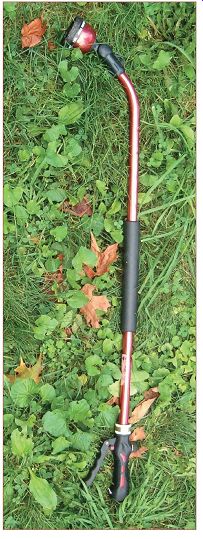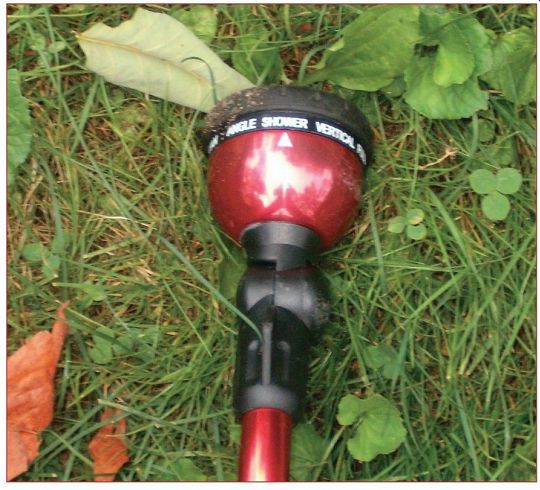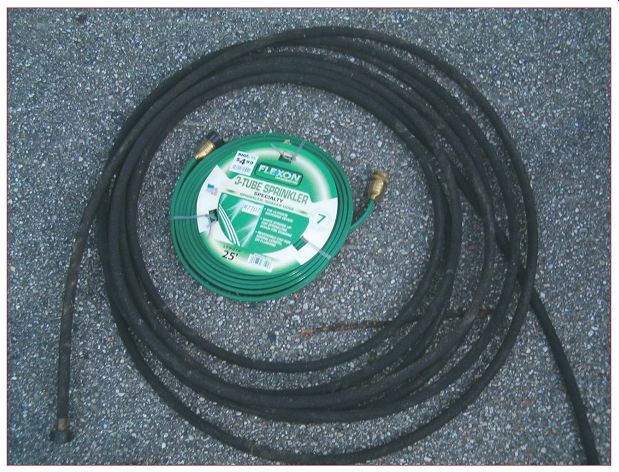Making sure that crops have the proper amount of water without overwatering them is important. Properly watered crops are more resistant to pests, absorb nutrients more consistently, and are generally stronger and more productive.
While it is possible to water crops a little bit daily, such an approach presents problems. For one thing, if enough water isn't used to soak down deep into the soil, the roots of the plants will stay close to the surface, making it impossible for the farmer to skip watering for a couple of days.
A better approach is to water extremely thoroughly but less frequently. A "thorough" watering is the equivalent of one inch of rain, which equates to about five pints of water per square foot of garden bed. Under normal conditions, this much water will soak deeply into the soil so that plant roots will become better established, and watering will be required only once a week, or twice a week during extremely hot weather . (Later in this section I describe how to determine how much watering is required if it has rained.) Garden soil, when dry, initially repels water . If water is simply dumped on top, the water will flow to the lowest spot it can find and pool there until it is absorbed. Get the soil a little damp first, and it will soak up water like a sponge.
There are as many approaches to watering gardens as there are gardeners. The Square Foot method waters each square foot of a raised bed individually using a ladle. The reasoning for this is not just water conservation but the fact that keeping foliage from being damp helps to prevent disease problems. This is true, but the problem lies in the fact that such a method of watering becomes burdensomely time-consuming when done on the scale of even a few hundred square feet.
The Grow Biointensive method imitates natural rainfall by using special watering attachments that make small droplets and let the water fall with only the force of gravity. By watering thoroughly each time, the frequency of watering is kept to about once a week.
This is a lot less time-consuming than watering each square foot individually, and because it waters thoroughly rather than frequently, it is better than daily watering regimens in terms of disease, though not as good as the Square Foot method in that regard. Agriculture, like anything else, requires compromises! All things being equal, using a watering wand is the best technique for a mini-farmer in the first couple of years.
Use of a Watering Wand
A watering wand can be used to duplicate natural rainfall. This is worthwhile, as typical watering attachments can allow the water to be too forceful, causing erosion and disrupting seeds and seedlings.

---- A watering wand allows delivery of water at the proper rate.
Most watering wands, but not all, have a movable head that allows the use of different settings for water flow. If you get one like this, make sure to select the "shower" setting. Unfortunately, when watering by hand, it is difficult to know how much water is being delivered. Luckily, it is easy to figure out.
Take a garden hose with the shower watering attachment installed, place it in a five-gallon bucket, and turn it on. (The shower watering attachment is also known as a "watering wand. " Use nothing but a watering wand if watering by hand or you'll damage your plants.) Use the sweep second hand on a watch to see how long it takes to fill up the bucket. If it takes two minutes to fill up the bucket, then you know that the flow rate of the hose and attachment is 2.5 gallons per minute. A 100-square-foot garden bed requires 62 gallons of water once a week. By dividing 62 by 2.5, you will discover that by watering the bed evenly for 25 minutes, you will add sufficient water . If your farm is anything like mine, most of the beds are roughly 4-foot × 8-foot, or 32 square feet.
That's roughly 1/3 of 100 square feet, so if you divide the 62 gallons of water for a 100-square-foot bed by three, you get 20 to 21 gallons of water for a 32-square-foot bed. If your attachment waters at 4 gallons per minute, then that means watering the bed for five minutes.

-------- Use the "shower" setting to avoid damaging plants.
This is obviously time-consuming. A three-person self-sufficient mini-farm will have more than a few beds, so hand watering would require a lot of time and be pretty boring. One way of avoiding monotony is to divide up the beds so that 1/5 of the beds are watered on each day of the week. Once you have expanded to a big enough mini-farm that watering chores are eating a lot of your time, you should arrange some sort of irrigation system (if possible) to optimize time usage.
Drip Irrigation
Probably the best approach in terms of time, efficiency, and disease prevention is drip irrigation in which tubes carry water to discrete areas of the garden at a predetermined rate of flow. It can be pretty expensive to install initially, but in the long run it pays for itself by freeing your time. One of the best aspects of drip irrigation systems is that they are modular and use standardized fittings, meaning that a farmer can start small and expand the system gradually as time and finances allow. Drip irrigation gives the benefits of watering each plant individually and keeping the foliage dry and thus discouraging diseases while saving considerable time.
Drip irrigation systems are rated in gallons per hour, either per foot or per emitter . (An emitter is a small device that delivers water from the system to the plants.) In the case of intensive agriculture, emitters should be spaced every 6 or 12 inches because the plants grow so closely together . Drip tape is ideal for intensive applications and should be run according to manufacturer's directions in such a way that there is at least one emitter per square foot of raised bed.
An automatic timer can be installed so that if the flow rate of the emitters is known, the time can be set to allow precisely the right amount of water . Keep a rain gauge in the garden, and you will know that the garden needs to be watered only when the amount of rain in a week is less than one inch. When the amount of rain that fell is less than one inch, the amount of water (in gallons) needed per square foot can be calculated using the following formula: 0.62 × (1 - z) where z is the number of inches of rain that fell that week.
Soaker Hoses
Not every mini-farmer will choose to install a drip irrigation or gray water recycling system. A good alternative is the use of soaker hoses. Soaker hoses can be laid lengthwise on top of the garden bed and snaked back and forth so that successive runs are no more than one foot apart. Alternatively, they can be buried in the garden beds no more than four inches deep. I tried burying a soaker hose about eight inches deep in a bed, and since most of a plant's roots are in the top six inches of soil, it didn't work out so well. Soaker hoses need to be on top of the soil or buried no more than four inches deep.

-------------
Two popular styles of soaker hose.
The watering rates of soaker hoses will vary by manufacturer.
One brand, made by Fiskars, waters at the rate of one gallon per hour per 10 linear feet of hose if connected to a 10-psi pressure regulator . Up to six lengths of soaker hose of up to 100 feet length each can be run from the same spigot/pressure regulator. Adding an automatic timer to the system makes watering effortless.
Calculating how long to leave the soaker turned on is straightforward. One inch of rain on a 100-square-foot garden bed is 62 gallons of water , and that is what is needed weekly for optimal plant health. If laid out properly, a 4-foot × 25-foot garden bed will use 100 feet of soaker hose. Since the hose waters at the rate of one gallon per hour per 10 linear feet, then 100 linear feet will put out 10 gallons of water an hour . So in six hours or so, 62 gallons will be delivered. When the automatic timer is set to water for six hours once a week, you are then free from watering chores except in the case of young seedlings that need to be watered by hand.
Gray Water Recycling
Gray water recycling is seldom considered as a means of watering crops. Household waste water is designated as either black water , meaning that it contains human waste, or gray water , which is everything else. If a home is equipped to handle gray water separately, then water that would otherwise go to waste can be used to water raised beds. The microbes in the raised beds and the plants themselves purify the gray water and derive nutrients from it. Such a system would contain a gray water holding tank and a pump, and the beds would contain embedded pipes with small holes drilled in them. (The Johnny Appleseed rest area in Massachusetts uses this technique.) Gray water can also be recycled using artificial wetlands that can double as a home for ducks or aquaculture of farm-raised fish. It stands to reason that toxic substances should never be dumped into a gray water system, so homes anticipating such a use need to "go green" in terms of the cleaning products they use.
----